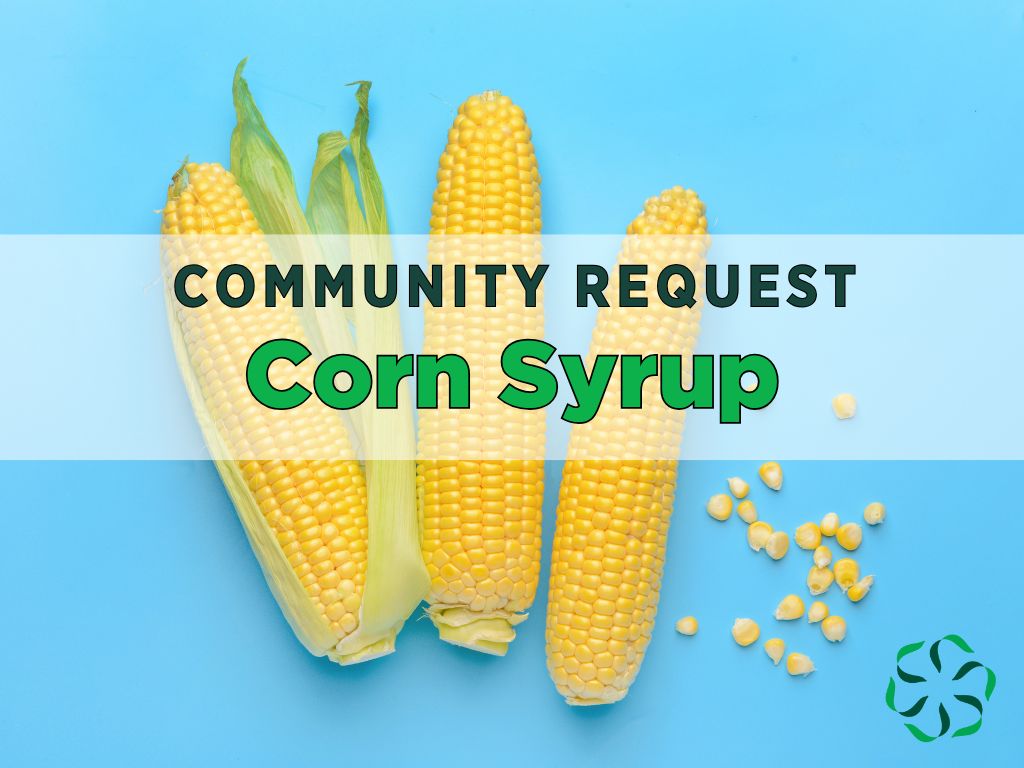Corn syrup has become one of the most talked-about and misunderstood ingredients on food labels. It’s often confused with high-fructose corn syrup and gets grouped into broad fears about “added sugars.” But what is corn syrup exactly, and should you be avoiding it? In this community request blog post, we look at corn syrup.
Top Takeaways:
- All sweeteners break down into the same basic biological building blocks.
- Corn syrup is not the same as high-fructose corn syrup (HFCS).
- Corn syrup is safe to consume in moderation.
What are sweeteners, and what types are there?
Sugar is a type of carbohydrate found naturally in many foods such as fruits, vegetables, grains, and dairy products. Sugar is added to foods in the form of sweeteners like table sugar, honey, maple syrup, corn syrup, and high-fructose corn syrup.
There are many types of sugar, but they break down into a few basic building blocks:
- glucose
- fructose
- galactose
These simple sugars combine to form compound sugars like sucrose (glucose + fructose, found in table sugar), lactose (glucose + galactose, found in dairy), and maltose (glucose + glucose, found in malted foods).
Whether the source is natural (like honey or maple syrup) or processed (like high-fructose corn syrup), nearly all sweeteners break down into these same basic components once digested.
What is corn syrup?
Corn syrup is a liquid sweetener made from corn starch. Through a process called hydrolysis, the starch is broken down into glucose, which is a type of sugar that your body uses for energy. The result is a thick, mildly sweet syrup that contains mainly glucose (not fructose).
What is corn syrup used for?
We use corn syrup in a wide range of foods and baked goods for more than just sweetness. It helps:
- Keep foods moist and chewy
- Prevent sugar crystallization (important in candy-making)
- Stabilize texture in sauces, jams, and frostings
- Add shine to glazes and fruit fillings
We’ll find it in products like marshmallows, soft caramels, jelly beans, and even salad dressings.
What types of corn syrup are there? Are they different?
Yes, there are different types of corn syrup, and understanding the distinction is key:
- Corn Syrup: Made of pure glucose, it’s less sweet than table sugar and is often labeled simply as “corn syrup” on food products.
- High-Fructose Corn Syrup (HFCS): This version goes through an extra enzymatic process that turns some of the glucose into fructose, making it sweeter and more similar to table sugar (sucrose).
- HFCS-42 (42% fructose): Used in cereals and baked goods.
- HFCS-55 (55% fructose): Used in soft drinks and sweetened beverages.
Note: Corn syrup and high-fructose corn syrup are not the same. They’re processed differently and contain different types of sugar.
Is corn syrup different than other types of sweeteners?
Yes. Here’s how it compares:
| Sweetener | Main Sugars | Sweetness (vs. table sugar) | Texture |
|---|---|---|---|
| Corn Syrup | Glucose | Less sweet | Thick and sticky |
| Table Sugar (Sucrose) | Glucose + Fructose | 100% | Granulated |
| High-Fructose Corn Syrup (HFCS) | Glucose + Fructose | Similar to table sugar | Syrupy |
| Honey | Glucose + Fructose + others | Slightly sweeter | Sticky liquid |
| Maple Syrup | Sucrose + trace minerals | Slightly less sweet | Runny liquid |
While they all deliver sweetness, their chemistry, texture, and how your body processes them can vary slightly.
Is corn syrup bad for me?
No, corn syrup is not inherently bad for our bodies. Like all sugars and sweeteners on the market, corn syrup is safe in moderation.
The health concerns arise when any added sugar—whether from corn syrup, HFCS, honey, or cane sugar—is consumed in excess.
Too much added sugar of any kind can increase the risk of:
- Weight gain
- Type 2 diabetes
- Heart disease
- Tooth decay
Regulatory agencies like the U.S. FDA and European Food Safety Authority (EFSA) consider corn syrup and HFCS safe to eat. The key is how much and how often we’re consuming added sugars, not whether it comes from corn, beets, or cane.
The good news.
Since corn syrup is not nutritionally different from other common sweeteners like table sugar or honey, and our body processes it in much the same way, we can enjoy corn syrup-sweetened foods and beverages in moderation. While it’s smart to watch your overall added sugar intake, there’s no need to fear corn syrup on its own as long as we’re consuming a diverse, balanced diet.
If you have any questions about ingredients or ideas for a blog post, please send us an email or submit your idea to us at go.msu.edu/cris-idea.
White, J. S. (2008). Straight talk about high‑fructose corn syrup: What it is and what it ain’t. The American Journal of Clinical Nutrition, 88(6), 1716S–1721S. https://doi.org/10.3945/ajcn.2008.25825B
Li, X., Luan, Y., Li, Y., Ye, S., Wang, G., Cai, X., Liang, Y., & Varkaneh, H. K. (2022). The effect of high‑fructose corn syrup vs. sucrose on anthropometric and metabolic parameters: A systematic review and meta‑analysis. Frontiers in Nutrition, 9, Article 1013310. https://doi.org/10.3389/fnut.2022.1013310
Raatz, S. K., Johnson, L. K., Kramer, K., & Picklo, M. J. (2015). Consumption of honey, sucrose, and high‑fructose corn syrup produces similar metabolic effects in glucose‑tolerant and ‑intolerant individuals. The Journal of Nutrition, 145(10), 2265–2272. https://doi.org/10.3945/jn.115.218016
Anderson, Zagorski, Center for Research on Ingredient Safety. Trending sweeteners. Michigan State University. Retrieved July 14, 2025, from https://cris.msu.edu/news/trending/trending-sweeteners/
Anderson, Zagorski, Center for Research on Ingredient Safety. Sugars. Michigan State University. Retrieved July 14, 2025, from https://cris.msu.edu/news/sweetener/sugars/

